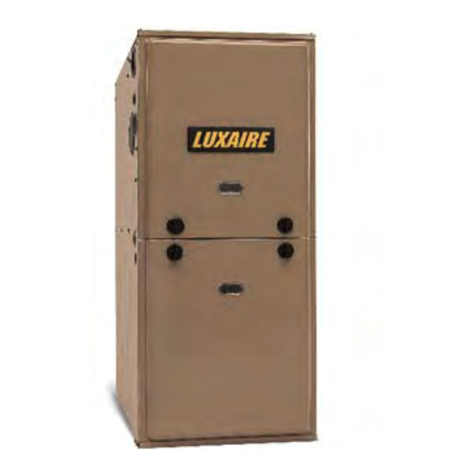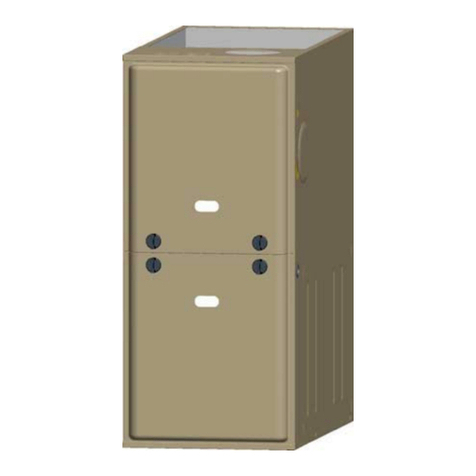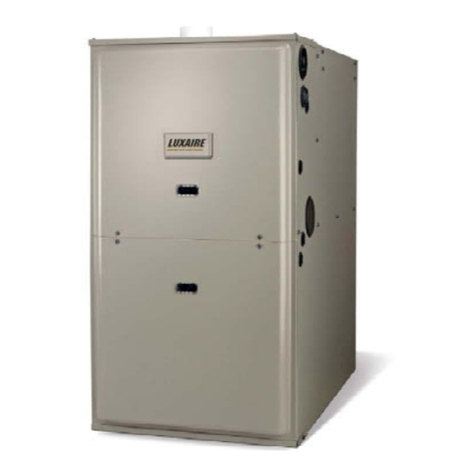
036-21013-002 Rev. A (5/00) Luxaire
4Unitary Products Group
FILTER PERFORMANCE
The airflow capacity data published in Blower Performance
Table above, represents blower performance WITHOUT fil-
ters. To determine the approximate blower performance of
the system, apply the filter drop value for the filter bein
used
or select an appropriate value from the Table below.
NOTE: The filter pressure drop values in Blower Performanc-
eTables are t
pical values for the t
pe of filter listed and
should onl
be used as a
uideline. Actual pressure drop rat-
in
s for each filter t
pe var
between filter manufacturer.
APPLYING FILTER PRESSURE DROP TO
DETERMINE SYSTEM AIRFLOW
To determine the approximate airflow of the unit with a filter in
place, follow the steps below:
1. Select the filter type.
2. Select the number of return air openin
s or calculate the
return openin
size in square inches to determine the
proper filter pressure drop.
3. Determine the External System Static Pressure (ESP)
without the filter.
4. Select a filter pressure drop from the table based upon
the number of return air openin
s or return air openin
size and add to the ESP from Step 3 to determine the
total system static.
5. If total system static matches a ESP value in the airflow
table (i.e. 0.20, 0.60, etc,) the system airflow corre-
sponds to the intersection of the ESP column and Model/
Blower Speed row.
6. If the total system static falls between ESP values in the
table (i.e. 0.58, 0.75, etc.), the static pressure may be
rounded to the nearest value in the table determinin
the
airflow usin
Step 5 or calculate the airflow by usin
the
followin
example.
Example: For a 120,000 Btuh furnace with 2 return openin
s
and operatin
on hi
h speed blower, it is found that total sys-
tem static is 0.58" w.c. To determine the system airflow, com-
plete the followin
steps:
1. Obtain the airflow values at 0.50" & 0.60" ESP.
Airflow @ 0.50": 2130 CFM
Airflow @ 0.60": 2050 CFM
2. Subtract the airflow @ 0.50" from the airflow @ 0.60" to
obtain airflow difference.
2050 - 2130 = -80 CFM
3. Subtract the total system static from 0.50" and divide this
difference by the difference in ESP values in the table,
0.60" - 0.50", to obtain a percenta
e.
(0.58 - 0.50) / (0.60 - 0.50) = 0.8
4. Multiply percenta
e by airflow difference to obtain airflow
reduction.
(0.8) x (-80) = -64
5. Subract airflow reduction value from airflow @ 0.50" to
obtain actual airflow @ 0.58" ESP.
2130 - 64 = 2066
FILTER PERFORMANCE - PRESSURE DROP INCHES W.C.
Airflow Range
Minimum Opening Size
(in.2)
Filter Type
Disposable Hogs Hair*Pleated
1 Opening 2 Openings 1 Opening 2 Openings 1 Opening 2 Openings 1 Opening 2 Openings
0 - 750 230 0.01 0.01 0.15
751 - 1000 330 0.05 0.05 0.20
1001 - 1250 330 0.10 0.10 0.20
1251 - 1500 330 0.10 0.10 0.25
1501 - 1750 380 658 0.15 0.09 0.14 0.08 0.30 0.17
1751 - 2000 380 658 0.19 0.11 0.18 0.10 0.30 0.17
2001 & Above 463 658 0.19 0.11 0.18 0.10 0.30 0.17
* Hogs Hair Filters are the type supplied with furnace (if supplied).






























